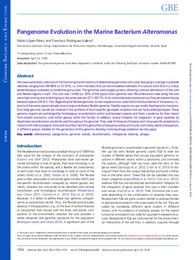Por favor, use este identificador para citar o enlazar este ítem:
https://hdl.handle.net/11000/4840
Pangenome Evolution in theMarine Bacterium Alteromonas
Título :
Pangenome Evolution in theMarine Bacterium Alteromonas |
Autor :
López Pérez, Mario
Rodríguez Valera, Francisco |
Departamento:
Departamentos de la UMH::Producción Vegetal y Microbiología |
Fecha de publicación:
2016-04-24 |
URI :
http://hdl.handle.net/11000/4840 |
Resumen :
Wehave examined a collection of the free-livingmarine bacterium Alteromonas genomeswith cores diverging in average nucleotide identities ranging from 99.98% to 73.35%, i.e., frommicrobes that can be consideredmembers of a natural clone (like in a clinical epidemiological outbreak) to borderline genus level. The genomes were largely syntenic allowing a precise delimitation of the core and flexible regions in each. The core was 1.4Mb (ca. 30% of the typical strain genome size). Recombination rates along the core
were high among strains belonging to the same species (37.7–83.7% of all nucleotide polymorphisms) but they decreased sharply
between species (18.9–5.1%). Regarding the flexible genome, itsmain expansion occurred within the boundaries of the species, i.e., strains of the same species already have a large and diverse flexible genome. Flexible regions occupy mostly fixed genomic locations.
Four large genomic islands are involved in the synthesis of strain-specific glycosydic receptors that we have called glycotypes. These genomic regions are exchanged by homologous recombination within and between species and there is evidence for their import from distant taxonomic units (other genera within the family). In addition, several hotspots for integration of gene cassettes by illegitimate recombination are distributed throughout the genome. They code for features that give each clone specific properties to interact with their ecological niche andmustflowfast throughout thewholegenus as they are found, withnearly identical sequences,
in different species. Models for the generation of this genomic diversity involving phage predation are discussed.
|
Palabras clave/Materias:
Alteromonas
pangenome
genomic islands
recombination
intraspecies diversity
phages |
Área de conocimiento :
Microbiología |
Tipo documento :
application/pdf |
Derechos de acceso:
info:eu-repo/semantics/openAccess |
DOI :
https://doi.org/10.1093/gbe/evw098 |
Aparece en las colecciones:
Artículos Producción vegetal y microbiología
|
 La licencia se describe como: Atribución-NonComercial-NoDerivada 4.0 Internacional.
La licencia se describe como: Atribución-NonComercial-NoDerivada 4.0 Internacional.
 La licencia se describe como: Atribución-NonComercial-NoDerivada 4.0 Internacional.
La licencia se describe como: Atribución-NonComercial-NoDerivada 4.0 Internacional.
.png)
